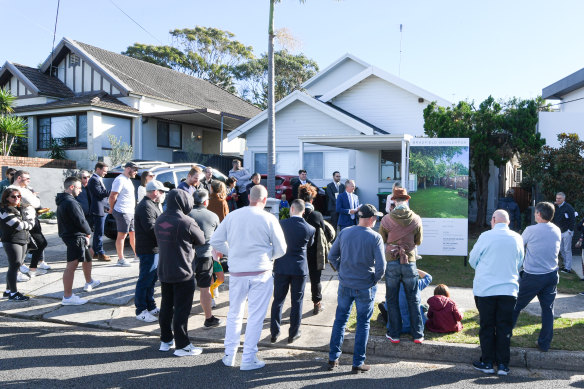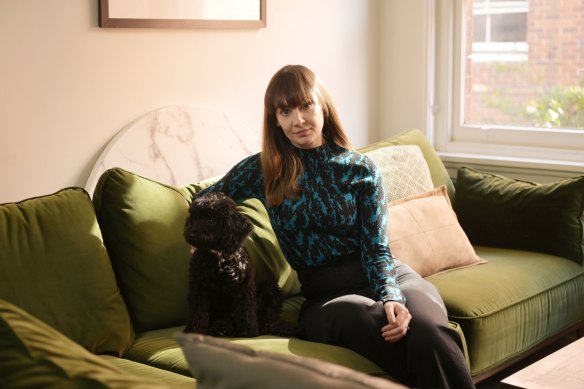This was published 1 year ago
The sought-after Sydney suburbs where property prices soared most
By Kate Burke and Jim Malo
High-end homes and more affordable abodes are leading Sydney’s property market rebound, as prices defy the drag of rising mortgage repayments.
Bellevue Hill topped the list for house price growth over the year to June, its median sale price lifting 18.4 per cent, the latest Domain House Price Report, released on Thursday, shows.

Sydney’s housing market had boom-level growth over the June quarter, underpinned by a shortage of homes for sale.Credit: Peter Rae
Bronte and Cronulla were also among the top-growth suburbs, as were Merrylands West, Auburn and Box Hill, all of which had values that increased more than 5 per cent.
Milsons Point had the most unit growth, up 25 per cent, while Wahroonga, Elizabeth Bay, Schofields, Meadowbank and Rockdale also had steep gains.
Sydneywide, house prices nudged 0.1 per cent higher over the year, after rebounding 5.3 per cent in the June quarter. Unit prices were down 0.7 per cent year-on-year, but lifted 2.6 per cent over the quarter.
Domain’s chief of research and economics Dr Nicola Powell said Sydney’s housing market had “boom time” growth over the quarter – underpinned by a shortage of homes for sale.
The biggest gains for houses were largely in the city’s west, while the greatest declines were generally on the northern beaches and upper north shore – where prices previously boomed when there was a flight to lifestyle areas early in the pandemic, Powell said.
“Areas that are more expensive also ... see bigger periods of up-growth and greater declines, they are more vulnerable and the strength [now] is in more affordable western suburbs.”
Prices were still down in more than three-quarters of analysed suburbs when compared to the year to June 2022, which coincided with the market boom.
For apartments, the largest declines were typically in more expensive, investor-heavy suburbs, largely in the city and east. But gains were spread across a mix of blue-chip and more affordable suburbs, supported by demand from cashed-up downsizers and first home buyers, respectively.
Powell said the pace of recent gains was unlikely to be sustained, due to affordability constraints, and a recent uptick in sellers, particularly investors. Some had likely been motivated by the price rebound, while others may be feeling the pressure of rising mortgage rates.
St George chief economist Besa Deda said the lopsided supply and demand situation was fuelling strong price growth.
“There’s a housing challenge that we’re facing,” she said. “We have strong population growth, but then there’s a shortage of dwellings across key parts of NSW ... and building approvals are well off their peaks and builders are still on the sidelines.”
Low listings levels and new home approvals would keep upward pressure on house prices for some time, Deda said, but noted the cash rate – and the possibility of further rises – would weigh heavily on the market and buyer demand.
“We have actually seen the auction clearance rates trend lower since May,” she said.
“Which suggests that the tighter rates are having a bit of an impact, but it may not be enough to undo the upturn [in prices], in an environment where there are still housing shortages.”
For buyers like Jacqui Duncan the supply shortage means facing strong competition for quality properties. She and her partner have missed out on multiple homes, in what is their second attempt to buy in Sydney.

Jacqui Duncan is looking to buy in Redfern, where she has faced strong competition for three-bedroom apartments.Credit: Nick Moir
“[We were trying in 2020] and we went to so many open homes, and we got the feeling that we were being outbid by parents buying their kids homes ... we took a step back and decided to just wait and put some of our capital into an investment property in Adelaide,” she said.
Having benefited from price growth in Adelaide – where unit values lifted 15.2 per cent annually – they’re selling to try to buy an apartment in Redfern, where prices are down just 1.6 per cent over the past 12 months compared to the previous 12 months.
“[Prices] are definitely back up there ... [and meanwhile] we’ve had rate rises, and that’s definitely reduced our borrowing capacity, so we’ve been focused on saving … a higher deposit than what we would have had.”
Their buyer’s agent Thomas Alpe, general manager at Cohen Handler, said buyer demand had remained solid during the downturn, buoyed by strong migration and an increase in tenants looking to purchase to escape the competitive rental market.
“There are a lot of buyers still looking, even with rate hikes … and when the right property comes up they’re not waiting [thinking prices could fall further] they’re jumping on it,” he said.
Though rising rates curbed borrowing power, many had not been going to their full capacity, Alpe said.
Meanwhile, first home buyer budgets had benefited from assistance schemes – like the short-lived property tax option and increased stamp duty relief – which allowed them to redirect more savings to their deposit.